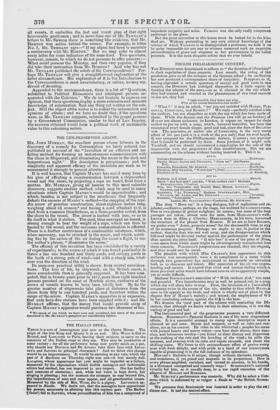THE LIFE - PRESERVING ARROW.
Mn. JOnsr MURRAY, the excellent person whose labours in the discovery of a remedy for Consumption we lately noticed, has published an account of the "Invention of an effective and un- failing method for forming an instantaneous communication with the shore in Shipwreck, and illuminating the scene in the dark and tempestuous night." His description is perspicuous ; and the simplicity and apparent efficacy of the invention are such as to recommend it strongly to general attention. It is well known, that Captain MANBY has saved many lives by his plan of effecting a communication between a shipwrecked vessel and the shore, by projecting a rope on board, fired from a mortar. Mr. MURRAY, giving all honour to this most valuable discovery, suggests another method which may be used in many situations where Captain MANBY'S would be impracticable ; and which, besides, is not subject to the mischance that frequently defeats the success of Mannv's method—the snapping of the rope. An arrow of peculiar construction, about eighteen inches long, weighing about 6i ounces,* and having a cord attached to it, is shot from a common blunderbuss, or a three-pounder swivel, from the shore to the vessel. The arrow is barbed with iron, so as to fa itself in what it strikes. The cord, thus conveyed on board, is strong enough to bear the weight of a rope, which can thus be hauled to the vessel, and the necessary communication is effected. There is a further contrivance of a combustible substance, which, when necessary, can be attached to the arrow, and which, catch- ing fire by the action of the air during the arrow's flight, to use the author's phrase, "illuminates the scene."
The efficacy of this invention has been established by a variety of experiments; in the course of which it was found practicable to throw a line one hundred and thirty yards, and seventy yards in the teeth of a strong gale of wind—and with a steady aim, what- ever was the direction of the wind.
Its immense, practical utility is shown from several considera- tions. The loss of life, by shipwreck, on the British coast, is more considerable than is generally supposed. It has been com- puted, that in twenty years prior to 1812, more than eight hundred persons perished on the coast of Norfolk alone, exclusive of the crews of vessels known to have been totally lost. By far the greater number of shipwrecks take place at distances from the shore from fifty to one hundred yards, and therefore within the range of the arrow. Captain MANBY'S apparatus is so expensive, that only forty-five stations have been supplied with it ; and Mr. MURRAY affirms, that the money that would provide sixty of Captain MANBY'S apparatus would purchase two thousand of his.
• We speak of one which we have seen and examined, but some of the arrows described in Mr. Mu (MAI'S pamphlet are considerably lighter.


























 Previous page
Previous page